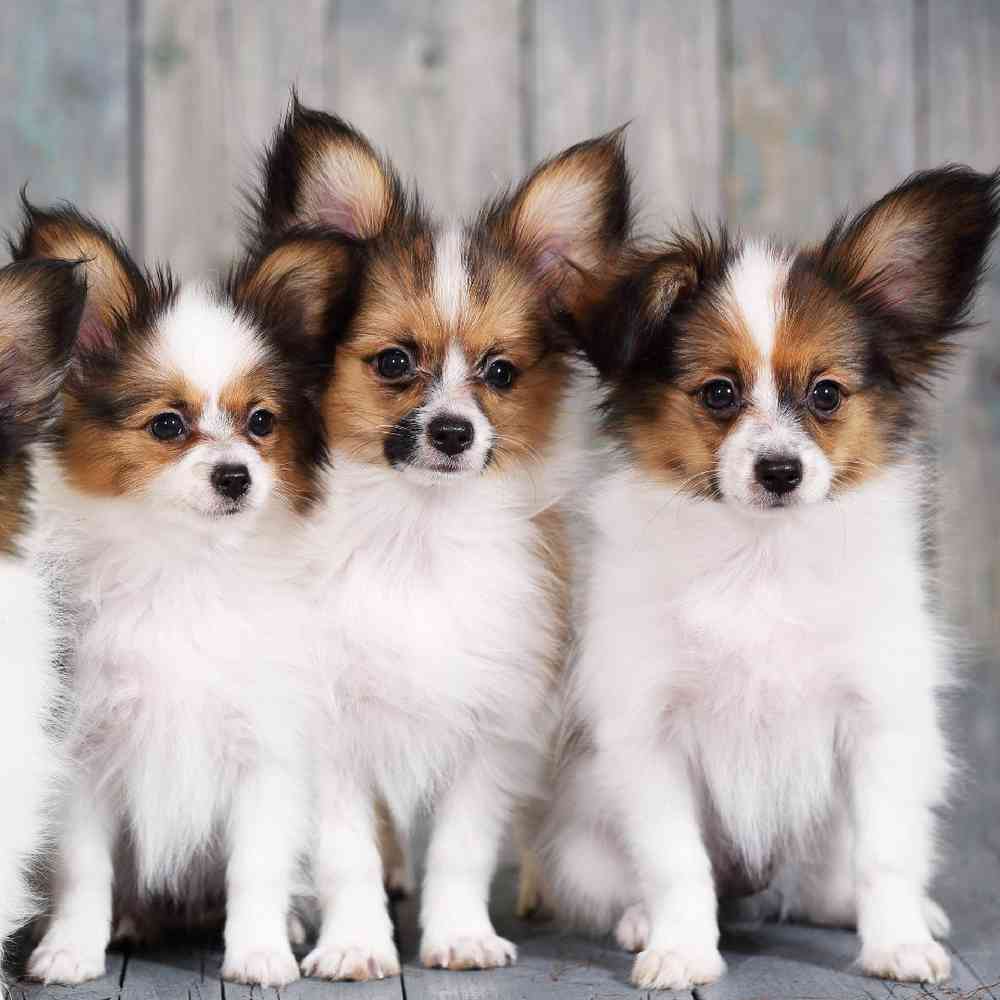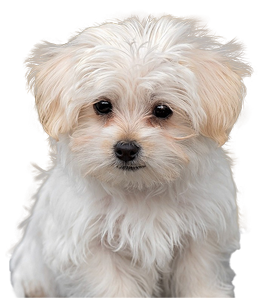
AKC Registrable
Apartment Friendly
Family Dog
Papillon
The quick, curious Papillon is a toy dog of singular beauty and upbeat athleticism. Despite his refined appearance, the Pap is truly a “doggy dog” blessed with a hardy constitution. Papillon fanciers describe their breed as happy, alert, and friendly.
Available Pups
Puppy Knowledge
Breed Info
Clubs, Registries & Associations
American Canine Association Continental Kennel Club Universal Kennel Club International American Kennel Club United All Breed Registry America's Pet Registry, Inc. United Kennel Club (Based on breed recognition. See store for details on this particular puppy.)
Group
Toy
Heritage
Historians have record of the Papillon going back 700 years ago. The Papillon appeared in 13th-15th century Renaissance period paintings, often depicted with French and Spanish noblewomen. The breed originally had ears that droped and were called a Phalene. Over time the ears changed to the erect ears we more frequently see today, and this type is called a Papillon. Both drop ears and erect ears can be seen in the same litter. They love to play, are naturally curious and excel at agility and competitive obedience.
Description
Very small, 8-11” (or more) at the shoulders, weighing anywhere from 5-10 pounds. Their short double coat comes in colors of tiger, brindle, fawn, and apricot.
Health Awareness
The Papillon has a life expectancy of 14-16 years. This breed is also prone to bloat, gastric torsion, cardiomyopathy, ectropion, hip and elbow dysplasia.
Personality
Dainty, amusing, playful, lively and highly intelligent, this little dog loves to cuddle with the family. They are quick to learn good manners and tricks, responding rapidly to positive reinforcement training. Great agility dogs, loving a good romp outdoors including play time with you. They can be difficult to potty train, though, and will require your continual supervision and commitment to teaching them how to use the correct area. While they are not athletic dogs, they do need exercise to keep them calm.
Exercise/Energy Level
Requires a daily walk with off leash playing to keep them exercised. Loves outdoor exercise.
Breed Standard
General Appearance
The Papillon is a small, friendly, elegant toy dog of fine-boned structure, light, dainty and of lively action; distinguished from other breeds by its beautiful butterfly-like ears.
Head
Eyes dark, round, not bulging, of medium size and alert in expression. The inner corners of the eyes are on line with the stop. Eye rims black. Ears - The ears of either the erect or drop type should be large with rounded tips, and set on the sides and toward the back of the head. (1) Ears of the erect type are carried obliquely and move like the spread wings of a butterfly. When alert, each ear forms an angle of approximately 45 degrees to the head. The leather should be of sufficient strength to maintain the erect position. (2) Ears of the drop type, known as the Phalene, are similar to the erect type, but are carried drooping and must be completely down. Faults - Ears small, pointed, set too high; one ear up, or ears partly down. Skull - The head is small. The skull is of medium width and slightly rounded between the ears. A well-defined stop is formed where the muzzle joins the skull. Muzzle - The muzzle is fine, abruptly thinner than the head, tapering to the nose. The length of the muzzle from the tip of the nose to stop is approximately one-third the length of the head from tip of nose to occiput. Nose black, small, rounded and slightly flat on top. The following fault shall be severely penalized - Nose not black. Lips tight, thin and black. Tongue must not be visible when jaws are closed. Bite - Teeth must meet in a scissors bite. Faults - Overshot or undershot.
Neck, Topline, Body
Neck of medium length. Topline - The backline is straight and level. Body - The chest is of medium depth with ribs well sprung. The belly is tucked up. Tail long, set high and carried well arched over the body. The tail is covered with a long, flowing plume. The plume may hang to either side of the body. Faults - Low-set tail; one not arched over the back, or too short.
Forequarters
Shoulders well developed and laid back to allow freedom of movement. Forelegs slender, fine-boned and must be straight. Removal of dewclaws on forelegs optional. Front feet thin and elongated (hare-like), pointing neither in nor out.
Hindquarters
Well developed and well angulated. The hind legs are slender, fine-boned, and parallel when viewed from behind. Hocks inclined neither in nor out. Dewclaws, if any, must be removed from hind legs. Hind feet thin and elongated (hare-like), pointing neither in nor out.
Coat
Abundant, long, fine, silky, flowing, straight with resilient quality, flat on back and sides of body. A profuse frill on chest. There is no undercoat. Hair short and close on skull, muzzle, front of forelegs, and from hind feet to hocks. Ears well fringed, with the inside covered with silken hair of medium length. Backs of the forelegs are covered with feathers diminishing to the pasterns. Hind legs are covered to the hocks with abundant breeches (culottes). Tail is covered with a long, flowing plume. Hair on feet is short, but fine tufts may appear over toes and grow beyond them, forming a point.
Color
Always parti-color or white with patches of any color(s). On the head, color(s) other than white must cover both ears, back and front, and extend without interruption from the ears over both eyes. A clearly defined white blaze and noseband are preferred to a solidly marked head. Symmetry of facial markings is desirable. The size, shape, placement, and presence or absence of patches of color on the body are without importance. Among the colors there is no preference, provided nose, eye rims and lips are well pigmented black. The following faults shall be severely penalized - Color other than white not covering both ears, back and front, or not extending from the ears over both eyes. A slight extension of the white collar onto the base of the ears, or a few white hairs interspersed among the color, shall not be penalized, provided the butterfly appearance is not sacrificed. Disqualifications - An all white dog or a dog with no white.
Additional Information
Always parti-color or white with patches of any color(s). On the head, color(s) other than white must cover both ears, back and front, and extend without interruption from the ears over both eyes. A clearly defined white blaze and noseband are preferred to a solidly marked head. Symmetry of facial markings is desirable. The size, shape, placement, and presence or absence of patches of color on the body are without importance. Among the colors there is no preference, provided nose, eye rims and lips are well pigmented black. The following faults shall be severely penalized - Color other than white not covering both ears, back and front, or not extending from the ears over both eyes. A slight extension of the white collar onto the base of the ears, or a few white hairs interspersed among the color, shall not be penalized, provided the butterfly appearance is not sacrificed. Disqualifications - An all white dog or a dog with no white.
Gait
Free, quick, easy, graceful, not paddlefooted, or stiff in hip movements.
Temperament
Friendly, Alert, Happy
Overview
About
A tiny dog, measuring 8 to 11 inches at the shoulder, you can still spot a Papillon a block away thanks to the large, wing-shaped ears that give the breed its name (“papillon” is French for “butterfly”). Some Paps have erect ears; in others, known as the Phalene type, the ears are down. Paps are dainty and elegant, with a plumed tail, and a long, silky coat of several color combinations, the base color being white. More robust than they look, Paps are little dogs for all seasons and reasons. They thrive in warm or cool climates, in town or country, and are eager to join family fun. They are excellent agility dogs and are consistent winners at the sport’s highest levels; less ambitious owners can train them to do all kinds of tricks.
History
Papillons were originally bred as charming and attentive companions for noblewomen, and for hundreds of years these enchanting lap warmers were great favorites in the royal courts of Europe. They appear in many portraits of long-ago queens and princesses painted by Europe’s most renowned artists. Rubens, Rembrandt, Goya, and Toulouse-Lautrec are among the masters who included Papillons in their paintings. Paps were developed in Renaissance times by crossing existing toy breeds with spaniels (the breed’s early ancestors were known as “dwarf spaniels”) in keeping with the era’s mania among nobles for miniaturized versions of their favorite breeds. The sporting-spaniel blood in the Pap’s background might explain why these dainty dynamos are among the more athletic and biddable toy dogs in the canine kingdom. With admirers like Madame de Pompadour, Louis XIV, and Marie Antoinette (whose Pap, named Thisbe, stood faithfully outside the prison where the hapless queen awaited beheading), the breed’s French connection is strong. But it was in the early breeding centers of Italy and Spain that Paps were refined and popularized. The AKC registered its first Papillon in 1915.
Standard
The Papillon is a small, friendly, elegant toy dog of fine-boned structure, light, dainty and of lively action; distinguished from other breeds by its beautiful butterfly-like ears.
Nutrition
The Papillon should do well on a high-quality dog food, whether commercially manufactured or home-prepared with your veterinarian’s supervision and approval. Any diet should be appropriate to the dog’s age (puppy, adult, or senior). Some dogs are prone to getting overweight, so watch your dog’s calorie consumption and weight level. Treats can be an important aid in training, but giving too many can cause obesity. Learn about which human foods are safe for dogs, and which are not. Check with your vet if you have any concerns about your dog’s weight or diet. Clean, fresh water should be available at all times.
Grooming
For a breed with long, silky hair, Papillons needs surprisingly little grooming, mostly because they do not have an undercoat. Grooming every month or so is fine. Between full grooming sessions, you might want to spend a few minutes running a comb or soft slicker brush through the hair inside the hind legs, behind the ears, and on the “culottes,” or thigh hair, as mats tend to form there. A Papillon will need a bath every few months, or when he or she gets especially muddy or dirty. The Papillon’s nails grow quickly and should be trimmed regularly—especially the dewclaw, which can curl around and pierce the leg. Finally, regular tooth brushing is vital for dental health.
Exercise
Thanks to their small size, Papillons make wonderful indoor pets, but that doesn’t mean they don’t need exercise. They are active, smart dogs, and they will want their people to play with them. Indoors, they enjoy retrieving a small ball or toy—a Papillon will quickly learn to bring it back so you can throw it again. Outdoors, true to their spaniel heritage, Papillons will happily run in the yard to chase after squirrels, chipmunks, and even insects. Papillons tend not to realize how small they actually are, so owners need to watch carefully if they set out after a larger dog, or even a cat.
Training
Papillons are intelligent and eager to please the humans they have bonded with. Generally speaking, some small breeds can take a little longer to housetrain than large breeds do, but Papillons make the process easier. Early socializationis very important, and obedience classes are a good idea—your Papillon will learn to do what you tell him to, and you will learn not to overindulge your adorable companion. And remember that the Papillon is a companion dog at heart; they may be unhappy and develop undesirable behaviors if left left alone for long periods of time. Fortunately, a Papillon can bond with other pets as well as humans.
Health
Papillons are tough and gutsy, but they are very small. Owners need to be careful with them, especially when they are puppies, around stairs, furniture, and other, larger animals. A small child can accidentally hurt his puppy friend very easily. Responsible breeders screen their stock for health conditions such as a fontanel in the top of the skull, similar to a human baby’s soft spot; and patellar luxation, or kneecaps that can “slip” or dislocate, sometimes briefly, sometimes completely.
Trivia
Interesting To Know
Translated, Papillon means butterfly, so named because their erect ears look like butterfly wings. Marie Antoinette's Papillon was found hiding in her skirts after her execution. The way the Papillon's tail curls over his or her's back, this breed carries the nickname of a "squirrel spaniel."




